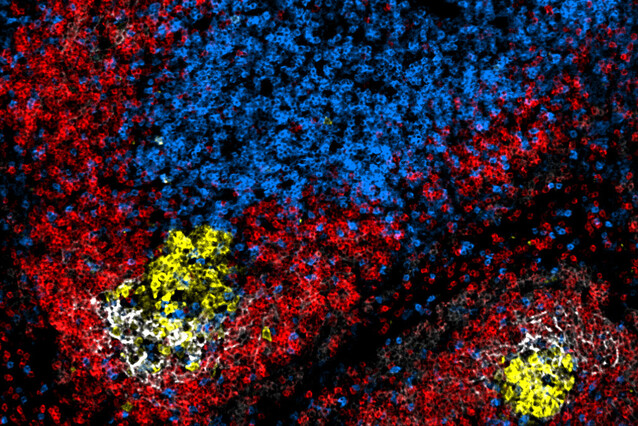Bhlhe40, a molecular gatekeeper that prevents the formation of lymphomas

B cells proliferate, differentiate, and mutate in temporary cell clusters called germinal centres. In a process known as the germinal centre reaction, B cells in these clusters mutate to improve the affinity of antibodies to fight invading pathogens. This reaction requires tight regulation, as uncontrolled cells may multiply in a frenzy and turn into lymphomas. An international team of scientists has unveiled the function of the transcription factor Bhlhe40, which restrains the size of germinal centres, thereby preventing the development of lymphomas in mice. Their findings are now published in the Journal of Experimental Medicine.
Our bodies detect pathogens such as bacteria and viruses through molecules secreted by B cells, called antibodies, which circulate in our body fluids upon infection. Our adaptive immune system recognises foreign antigens with the help of highly specialised antibodies, as well as receptors on the surface of immune cells.
To recognise the thousands of pathogens we encounter, B cells carry a vast repertoire of receptors. Furthermore, some activated B cells rapidly divide, differentiate, and mutate in specific anatomical structures, called germinal centres, to further improve the effectiveness of antibodies.
Germinal centres consist of temporary cell clusters found in the lymph nodes, the spleen, and other lymphoid organs. They contain two main groups of cells: germinal centre B cells and a specialised type of T cells, called follicular helper T cells (TFH). In the germinal centre reaction, these cells boost the proliferation of B cells, which modify their antibody genes through somatic hypermutation. From the diverse set of resulting B cells, those which do best at binding antigens are selected and undergo another round of proliferation and somatic hypermutation.
Immunologists have identified several molecular regulators that activate the germinal centre reaction. However, little is known about the negative regulators of this process. In their latest study now published in the Journal of Experimental Medicine, scientists in the Busslinger Lab at the IMP and Kreslavsky Lab at Karolinska Institutet pinpoint the role of the transcription factor Bhlhe40 as a negative regulator of the germinal centre reaction.
Restraining B cell differentiation and T cell proliferation
Many key regulators of the germinal centre reaction affect B cells and T cells simultaneously, but through different molecular mechanisms. Bhlhe40 is no exception to this tendency.
The scientists found that Bhlhe40 downregulates the differentiation of activated B cells into germinal centre B cells and restricts the proliferation of TFH cells.
“We observed that the absence of Bhlhe40 results in an abnormal increase in the number of germinal centre B and T follicular helper cells,” says René Rauschmeier, PhD student in the Vienna BioCenter PhD Programme and co-first author of the study. “Our results demonstrate that Bhlhe40 is a gatekeeper of the formation and normal development of germinal centres.”
Bhlhe40 is crucial to prevent the formation of lymphomas
While the germinal centre reaction is necessary for our bodies to defend themselves against a wide variety of pathogens, it can also lead to disease if it fails to function properly. Lymphomas, a group of blood tumours, develop when the proliferation of immune cells is dysregulated. A wide variety of B-cell lymphomas arise when the germinal centre reaction is out of control, producing more and more B cells without restraint.
The researchers observed that mice which do not express Bhlhe40 developed B-cell lymphomas as they aged. “Our study shows that Bhlhe40 is one of the molecular factors that maintain a healthy rate of cell division in germinal centres and prevents the emergence of B-cell lymphomas,” says Meinrad Busslinger, Deputy Scientific Director of the IMP. “Whether these results hold true for the human immune system is yet to be confirmed.”
Original publication
*These authors contributed equally to the study.
Further reading